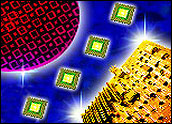
Worldwide sales of semiconductors rose to US$22.6 billion in November — a 3.7 percent increase from October when sales were $21.8 billion, according to new statistics from the Semiconductor Industry Association. Sales for November 2009 were 8.5 percent higher than November 2008’s $20.9 billion total — marking the first time for the year they were in positive territory.
The numbers add to the growing pile of statistical and anecdotal evidence that a tech recovery is under way. To be sure, SIA’s figures were not universally good. It reported that sales for the first 11 months of 2009 were $202.1 billion, a decline of 13.2 percent from the same period in 2008, when sales were $232.7 billion.
Still, with its sequential 3.7 percent increase, November became the ninth consecutive month of increased chip sales, across all geographic regions.
There is still a great deal of uncertainty surrounding the subject of a tech recovery, SIA spokesperson John Greenagel told the E-Commerce Times. However, the “steady improvement after a steep decline does bode well. It is a cliche for semiconductor sales that there is no such thing as a soft landing or gradual recovery. Well, we certainly had a hard landing, so now we’re hoping for a sharp recovery.”
Major Consumer Shift
The 2009 holiday season is one reason to expect that the trend will continue.
“I haven’t seen final numbers yet,” Greenagel said, “but anecdotally, there are a lot of reports of increased consumer spending on electronics and other products that carry these chips. That will help as well.”
Indeed, the semiconductor industry has undergone a radical shift in the last few years, with consumers becoming the drivers behind its growth — or lack thereof. “For many years, government and military spending was the primary driver. Then it was the corporate IT space,” Greenagel said.
“Now, half of all semiconductor chips are embedded in products that are purchased by individuals or families,” he noted. Such products range from cellphones to HDTVs to electronic games to digital cameras and frames.
Personal computers, of course, also use chips, and recent sales — as well as new projections of future growth — are signaling the recovery of demand from the business sector.
In particular, the release of Microsoft’s Windows 7 operating system in October was a positive factor, SIA said.
Despite the recession, the association is also expecting unit sales of handsets to come in roughly even with 2008 levels.
Also, purchases of LCD TVs units increased by 25 percent to 30 percent in 2009.
Cautious Projections
While any industry-generated statistics should be taken with grain of salt, the SIA is generally cautious in its projections — another plus for the tech industry pinning its hopes on a strong 2010, Charles King, principal of Pund-IT, told the E-Commerce Times, adding that he feels cautiously optimistic about the coming year.
“I think the general consensus is that the economy is stabilizing and moving upward a bit and that will spell a positive outcome for the IT industry,” he said.
There has also been news of interesting products in the last few weeks that should drive sales, added King — namely the strong rumors about Apple’s tablet computer and Google’s smartphone, widely expected to be announced this week.
Although Windows 7 is the main driver of tech growth, “if you look at the amount of buzz created over the last week or so by Apple and Google,” King commented, “it is obvious that there is a new appetite for next-generation technology and ideas among consumers.”
As long as the industry is able to create buzz and engage with its top customers, this trend should continue, he said.






















































Social Media
See all Social Media